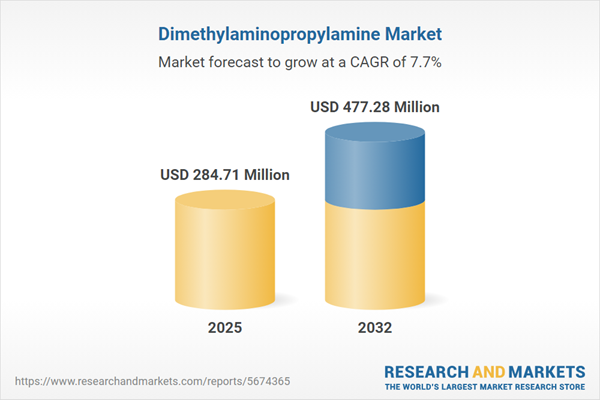Speak directly to the analyst to clarify any post sales queries you may have.
Senior leaders in the chemical industry face rising regulatory challenges and a need for efficient procurement and supply chain strategies. In this environment, access to current, actionable intelligence on the dimethylaminopropylamine market is critical for maintaining compliance and supporting operational resilience as sector dynamics evolve.
Dimethylaminopropylamine Market Snapshot
The dimethylaminopropylamine market is experiencing steady expansion, propelled by increased demand and buyer consolidation across core industries. The current market valuation stands at USD 264.40 million, with short-term projections reaching USD 284.71 million and a longer-term outlook of USD 477.28 million by 2032. This equates to a consistent CAGR of 7.66%. Heightened competitive pressures are prompting organizations to intensify efforts around sourcing efficiency and regulatory compliance. Companies are investing in advanced supply chain and operational strategies to better serve international clients and achieve effective downstream integration in an evolving global marketplace.
Scope & Segmentation of the Dimethylaminopropylamine Market
This executive market report provides procurement and risk management teams with data to inform strategy alignment as industry transformation accelerates. It delivers insight into the priorities shaping decisions across key market segments:
- Purity Grade: Reagent and technical grades support adherence to strict manufacturing, quality, and regulatory requirements across multiple sectors.
- Application: Utilized in adhesives, sealants, surfactants, corrosion inhibitors, oilfield chemicals, and specialty formulations to drive process efficiency and end-product performance.
- Adhesives & Sealants: Enhance durability and lifespan, essential for infrastructure and industrial maintenance objectives.
- Oilfield Chemicals: Enable compliant drilling and extraction, contributing to operational reliability in energy markets.
- Surfactants: Critical for dispersion functions, these applications boost both bulk and specialty chemical innovation.
- End User: Customization meets requirements in agrochemicals, pharmaceuticals, oil and gas, water treatment, and general chemical industries, prioritizing operational excellence and regulatory alignment.
- Agrochemicals: Aids development of sustainable products that address ongoing changes in regulatory frameworks and market expectations.
- Pharmaceuticals: Enables the manufacture of intermediates in compliance with global quality standards.
- Water Treatment: Addresses municipal and industrial needs, with an emphasis on scalable and sustainable solutions that reduce risk.
- Distribution Channel: Direct sales, distributors, trading houses, and value-added suppliers provide diversified sourcing solutions for commercial buyers.
- Regional Coverage: Encompasses the Americas, Europe, Middle East, Africa, and Asia-Pacific, with each region demonstrating unique regulatory and growth dynamics impacting strategic planning.
- Leading Companies: Market participants include BASF SE, Evonik Industries AG, Clariant AG, Huntsman Corporation, Solvay SA, Sasol Limited, Mitsubishi Chemical Holdings Corporation, Alkyl Amines Chemicals Ltd., and Eastman Chemical Company, each bringing distinct expertise and geographical strengths.
Key Takeaways for Senior Leadership
- Expansion in specialty chemical portfolios enables organizations to address evolving requirements across diverse end markets and maintain strategic flexibility.
- The introduction of automation and advanced digital monitoring enhances efficiency, offering improved compliance and data-driven operational insights for better decision-making.
- Sourcing is increasingly focused on renewable and sustainable inputs, as companies prepare for tightening environmental regulations and pressure from stakeholders.
- Regional differentiation is evident, with the Americas prioritizing high-volume production, Europe emphasizing progress on regulatory fronts, and Asia-Pacific advancing integration of new technologies.
- Across pharmaceuticals, agrochemicals, and water treatment, tailored supply solutions ensure compliance with both global standards and specific regional mandates.
- Entering or maintaining robust supplier relationships fortifies operational stability, especially amid market volatility and shifting geopolitical factors.
Tariff Impact and Supply Chain Dynamics
Recent tariff adjustments in the United States have caused supply chain realignment, prompting leading organizations to seek longer-term supply agreements and implement structured inventory strategies. By doing so, they support operational continuity and risk mitigation within an increasingly complex compliance landscape. These measures contribute to maintaining reliable supply flows as international trade policies evolve.
Methodology & Data Sources
This chemical market research integrates insights from interviews with senior executives and rigorous assessments of technical and regulatory documentation. Triangulation and time-series analysis underpin the validation of findings, giving leaders credible insights for confident implementation.
Why This Report Matters
- Supplies actionable market intelligence so organizations can address business risk and efficiently navigate complex regulations impacting the dimethylaminopropylamine sector.
- Enables executive teams to harness current technologies, optimize supplier management, and implement effective process improvements informed by reliable data.
- Strengthens sustainability programs and risk resilience to help organizations meet stakeholder expectations as the business environment changes.
Conclusion
This report offers chemical industry executives the clarity and insight required to make timely strategic decisions, enhance supply chain adaptability, and proactively address the sector’s shifting regulatory landscape.
Additional Product Information:
- Purchase of this report includes 1 year online access with quarterly updates.
- This report can be updated on request. Please contact our Customer Experience team using the Ask a Question widget on our website.
Table of Contents
3. Executive Summary
4. Market Overview
7. Cumulative Impact of Artificial Intelligence 2025
Companies Mentioned
The companies profiled in this Dimethylaminopropylamine market report include:- BASF SE
- Evonik Industries AG
- Clariant AG
- Huntsman Corporation
- Solvay SA
- Sasol Limited
- Mitsubishi Chemical Holdings Corporation
- Alkyl Amines Chemicals Ltd.
- Eastman Chemical Company
Table Information
| Report Attribute | Details |
|---|---|
| No. of Pages | 192 |
| Published | November 2025 |
| Forecast Period | 2025 - 2032 |
| Estimated Market Value ( USD | $ 284.71 Million |
| Forecasted Market Value ( USD | $ 477.28 Million |
| Compound Annual Growth Rate | 7.6% |
| Regions Covered | Global |
| No. of Companies Mentioned | 10 |









